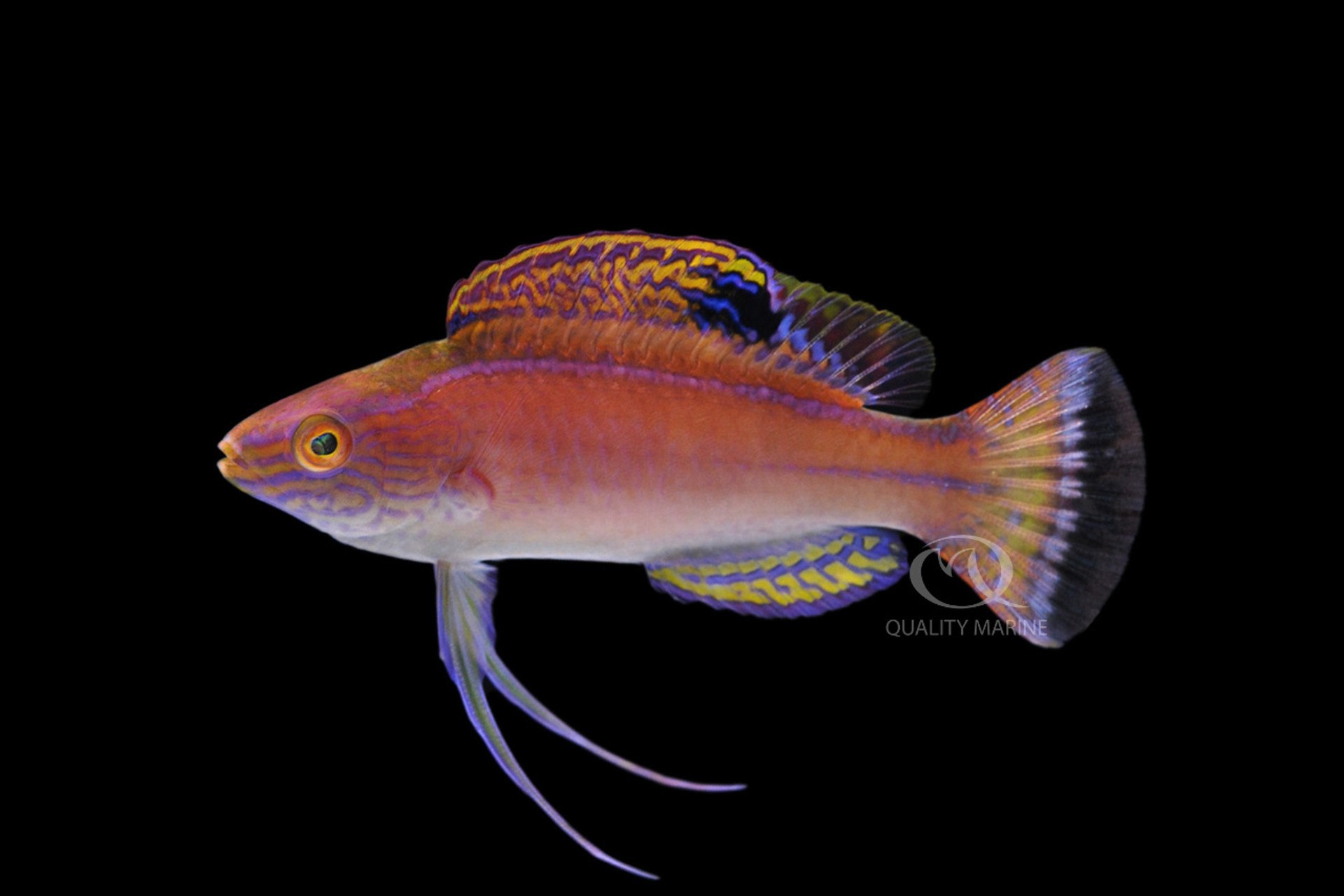When Is A Pyle Not A Pyle? When It's A Latigo (of course)

Cirrhilabrus is a genus of wrasses that contains dozens of species, nearly all of which are gorgeous, reef safe fish that are small in stature, and peaceful with tankmates. The sheer volume of the species available to the home aquarist can be daunting, and with some of them, there is substantial overlap, either in appearance, or range, habitat or all three! Sometimes, you get Cirrhilabrus wrasses that have striking similarities in appearance but come from different locations or habitats. Such is the case with the Latigo Fairy Wrasse (Cirrhilabrus briangreenei.) This is a fish that looks a bit like a Pyle's Wrasse also frequently called the Blue Margined Fairy (Cirrhilibrus pylei) crossed with a Lineatus Fairy Wrasse (Cirrhilabrus lineatus). The Latigo wrasse also bears passing similarities to the Rhomboid Fairy wrasse. While these are all deepwater reef fish, the Latigo Wrasse comes from the Philippines, a location that the Pyle's Wrasse is conspicuously missing from.
There are some morphological differences between these fish as well. The easiest being the presence of a large dark spot on the dorsal fin of the Latigo Wrasse that is missing from either of the other two. Once they are all adult male coloration, the similarities between Latigo Wrasses and both Rhomboid and Lineatus Wrasses fade away substantially. For those of you who are interested in fin ray counts and the myriad of other details that go into speciation, you should check out the paper describing them. There is an excerpt of this paper here: https://bioone.org/journals/Copeia/volume-108/issue-1/CI-19-297/A-New-Species-of-Fairy-Wrasse-Teleostei--Labridae/10.1643/CI-19-297.short

The Latigo Fairy Wrasse has been around for quite a while in the aquarium hobby, though for most of this time, it was described as a color form of Pyle's Wrasse, a result of their similar appearances. In 2020 it was described as its own species (see link above). A true rarity in the fish world, the Latigo Fairy Wrasse has only the one common name (except for all of the things it was erroneously called previously). It got its scientific name (binomial nomenclature) to honor Brian Greene, a self-described Ichthology Researcher of some fame who currently hails from Hawaii.
There aren't too many tough things in regard to the actual husbandry of Latigo wrasses. Like nearly all of their close relatives, these wrasses like stable environments that are very clean. Any quality salt like Tropic Marin, mixed to manufacturer's instructions, will give you a great profile for keeping Latigo wrasses. Specific gravity should measure around 1.025. They will appreciate stability in pH and temperature, and while the pH should be 8 or a bit higher, the temperature should be a little lower. This wrasse will do best in the low range of tropical temperatures, think mid 70s Fahrenheit.
In regard to the physical tank requirements, they don't need an overly large amount of space, and a 75-gallon aquarium would be more than ample for keeping a trio (a natural distribution for this critter.) They will appreciate a lot of flow which is good for those of you looking to keep them in reef style aquariums. Conversely, they come from very deep water, up to 350 feet down, and so they should be acclimated to bright lighting conditions slowly. Latigo Fairy Wrasses can be very shy, especially upon initial introduction, and like most shy fish, they love copious rockwork with multiple hiding places and swim-throughs. The more places they have to hide, the more secure they will feel, and the more you will see them, especially initially. We strongly recommend a covered display for this fish, as they can hit a surprisingly fast turn of speed, and if they do that in the wrong direction, they can easily end up on the floor.
This shy behavior plays into feeding these fish as well. They are very active and will need at least two feedings a day. Initially, they may hide through mealtimes as they don't like the commotion of it. They usually adjust pretty quickly, and in house, we have no problems getting them to eat. In house, they get fed twice a day, and get a mix of thawed, appropriately sized meaty foods from Gamma Foods, like chopped prawn, mysis, and loaded brine, as well as the sinking 1.7mm Nutramar Marine Complete Pellets. These are well accepted by the Latigo Fairies, and we have excellent results feeding them.
Like all Cirrhilabrus, Latigo Fairy Wrasses are extremely unlikely to bother your corals or invertebrates of any kind. The only caveat to choosing tankmates with them is to keep them with other fish that aren't overly boisterous (or that will pick on their fins). Avoid fish like Damsels, Triggers, Puffers etc. Good tank mates would be Firefish, Clowns, Cardinals etc. Keeping them with other Cirrhilabrus is also a good idea, though you should pick other females, or keep them in a “harem” group of Latigo wrasses with two or three females to every male. They are unlikely to be aggressive with females of other species in the genus, and even multiple males would be okay in a large enough environment.
Long story short, this is an absolutely gorgeous fish, and rare enough in its own right so that you are unlikely to see another one in a friend's aquarium. They are hardy, active and peaceful enough to keep in marine community tanks. They are as reef safe as a fish can be and honestly, what are you waiting for? Head to your LFS ASAP (local fish store as soon as possible) and ask them for a trio of Latigo Fairy Wrasses from Quality Marine today!